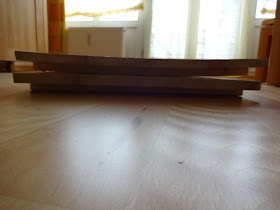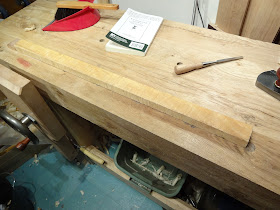This is more than just a project DVD. If you have no intention of making this table, you still should watch it.
Why?
Because in this DVD CS discusses and demonstrates hand joinery techniques for nearly any kind of carcass furniture.
I think one should build this table if for no other reason than it is a perfect exercise for building your first piece of furniture entirely with hand tools.
Let's look a little closer at this DVD:
The price from Lie Neilsen is $40. This seems like a lot for a DVD, as you can get the latest Harry Potter movie on Amazon for $6.49. If you want a good afternoon of entertainment for cheap, go with Harry Potter. If you want to learn to build furniture by hand, CS's DVD is a fantastic bargain.
This DVD is 269 minutes in length. That is almost four and a half hours! Plus, the DVD contains some other information you can access on your computer such as Sketch Up plans.
I found I couldn't absorb this whole thing at once. It took me two days to get through it.
Here is the important bit: I have been to a few of CS's classes, and the information he shares here is exactly the same. It is delivered in the same easy to absorb language. There are not a lot of teachers who can make the transition to teaching on a video without boring you to death or skipping all the important parts.
In this DVD, the shaker side table isn't the most important part. It is the delivery of the techniques used on all of the different processes. This small project is full of them. You'll get to see CS show you how to do the following:
- Choose lumber and orient it for this project for beauty and ease of hand tooling
- process stock by hand including gluing up a panel and flattening a wide piece for the top
- taper table legs with a hand plane
- mortise and tenon joinery
- dovetails, both through and half blind
- drawer construction and fitting
- chamfers
- layout of all joints and cuts
- finish the piece
- a lot more that doesn't come instantly to mind
Chris does make everything look easy. However, he explains it in his way which I know he does to give woodworkers the best likelihood of achieving success. In other words, there are many different ways to cut a joint, but he chooses methods designed for ease of learning.
I would also like to give credit to Tom Lie-Nielsen for producing this video. As the head dude in charge of his tool company, it is obvious he gave Chris free reign to do everything his own way. Chris uses the Lie-Neilsen tools in this video from his own working kit, but there are some other companies whose tools make an appearance in this video. For example, Chris spends a good bit of time demonstrating and discussing the Veritas Skew Rabbet Plane. How many other CEOs would produce a video where the star advocated the use of the product of a competitor? The answer, of course, is that what is good for woodworking in general is good for Lie-Nielsen, as well as all fine tool makers.
If you truly are a hand tool newbie, then this DVD is a great place to start. The only prerequisite is that you know how to sharpen your tools. Chris has two DVDs that cover this really well: The Last Word on Sharpening, or Handplane Basics. Either one of these DVDs will show a beginner how to sharpen planes and chisels to the kind of edges that are required for this project.
If you have more projects under your belt than that, I guarantee you that there is something in this DVD that you are ready to hear.
The positives for this DVD in my opinion far outweigh the negatives. However, in the pursuit of providing full disclosure, there are a few things that might be considered minor drawbacks. This will seem like nitpicking, which of course it is.
I am not so sure maple was the best choice for this DVD. Not because it isn't a good wood for this project, but because it doesn't photograph very well. The beauty of the grain was lost on my TV. I think perhaps if the cover photo showed the table in cherry or walnut, the spousal unit might be a bit more interested in seeing this project built. What we as woodworkers can get from this, though, is that maple is not known for being an easy wood for hand tools. If I can see Chris do it in maple, even I should be able to find success with cherry.
The other bit of nitpicking is Chris uses tools that are his own tool chest. Since this is a great project for a beginner, some alternate methods with a more basic tool kit might be discussed. For example, in his book the ATC, a jointer and a smooth plane are on his nice-to-have list. He doesn't distinguish this in the video, nor demonstrate how one might approach this project without them. On the other hand, it is nice to see these tools demonstrated being used how they are meant to be used.
In conclusion, I think every woodworker would benefit from this project video. Even if you are a power-tool only woodworker, making this table entirely by hand might show you some methods you might choose to add to your bag of tricks. If you don't want to build this particular table, you can use the same methods and joints for practically any other project that is on your to-do list.
Me, I'll be building this table as soon as I am done with the project I am currently working on.

























